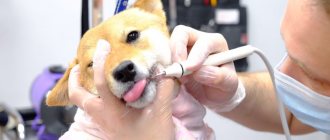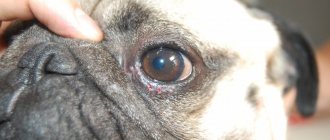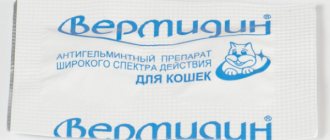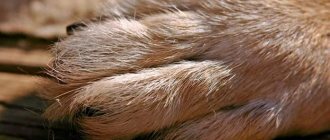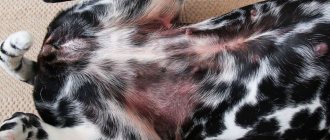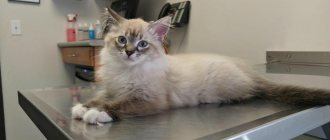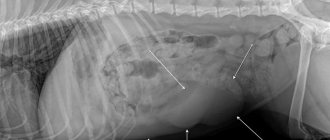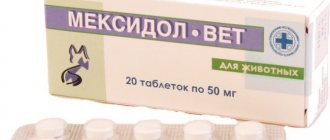All animals sooner or later encounter tartar on their teeth because they do not have the opportunity to use a toothbrush. Tartar in dogs' teeth can lead to a number of digestive problems and even infections. This is why it is so important to closely monitor your dog’s health and periodically examine his oral cavity.
What is tartar on dogs' teeth?
Solid compounds of food particles and microorganisms, impregnated with minerals, can form unnoticed over four to six months. Initially, you can see a thin film, which contains microbes and their waste products. If you do not take care of your dog’s mouth and do not monitor your pet’s hygiene, then the food debris will begin to layer on top of each other, the plaque will thicken, and as a result, a stone plaque will appear.
Plaque quickly spreads throughout the oral cavity, affecting the enamel of closely spaced teeth. Darkening occurs gradually, changing over time from yellow to brown.
Seals can be located above the gum and below the gum. In the first case, the problem can be easily noticed by the owner himself during regular inspection. This option is less dangerous, since it can be easily removed without damaging the enamel.
The second option is characterized by greater hardness and a darker shade. In this case, the stone is fixed between the root and the alveolus, so it is not easy to eliminate. First of all, the fangs and incisors are affected, and then the disease spreads to the entire jaw.
At first, the stone formations do not cause any inconvenience to the animal, but as they accumulate, the first alarm bells appear. It is important to regularly examine your dog's mouth, brush his teeth thoroughly, and visit a canine dentist once a year.
A little about tartar
Before moving directly to the methods of treating tartar, let's understand its features. Tartar is formed as a result of the complex interaction of several ingredients at once:
- calcium and phosphorus are minerals that form bone tissue;
- iron;
- particles of chewed food remaining in the mouth;
- bacteria and the results of their functioning.
Several factors are involved in the formation of tartar.
Development of stone
At the initial stage of its formation, tartar is not actually a stone. It is a loose coating formed from unrefined remains of chewed foods, as well as accumulations of bacteria. This plaque is pale yellow in color and can be easily removed at home with a brush.
Tartar develops most quickly where there is no constant friction between the teeth and the plaque build-up that forms is not removed naturally. The plaque begins to thicken, gradually turning into what is called calculus. The gradual darkening of the stone is explained by the fact that the plaque has a porous structure, which facilitates its rapid absorption of dyes.
Stages of tartar formation in dogs and cats
The plaque, in turn, hardens due to the fact that it contains microorganisms that secrete insoluble mineral compounds. On average, the formation of tartar can take from three to six months, depending on the structure of the dog’s teeth and the characteristics of its feeding.
Location of the stone
Experts distinguish two types of tartar, depending on its location:
- Supragingival stone: such a stone can be noticed by the owner himself without special dental equipment, since it is located above the upper edge of the gums. The supragingival stone is easily removed from the enamel;
- Subgingival stone: It is harder and darker in color. It is much more difficult to work with such a stone due to its difficult location - between the root of the tooth and the alveolus. Subgingival stone sometimes cannot be removed even with the help of ordinary dental devices.
Stones can be located both above and below the gum
By the way! The stone prefers to form on the fangs and incisors, later spreading to other teeth. Also, first of all, plaque usually appears on the upper jaw.
Reasons for the problem
Stone plaques form in hard-to-reach places under unfavorable conditions and lack of hygiene. There are several factors that can cause tartar to appear on a dog’s teeth.
Incorrect selection of feed
The risk of plaque increases significantly if the pet is fed soft food. It does not contribute to prolonged friction of the jaw surfaces and self-cleaning of the teeth. Constantly feeding an animal canned food is the main mistake of modern breeders. It should be remembered that the dog’s teeth need active use. If you stop using the incisors, canines, and molars, the jaw will begin to deteriorate.
Dry food partly solves the problem, since solid particles clean off the initial plaque. But this does not mean at all that dogs consuming “drying” are protected from the formation of tartar.
Impaired metabolism
Excessive carbohydrate content in food leads to a weakening of the body's protective functions. You shouldn’t spoil your furry friend with “tasty food.” Experienced breeders know that sweets are contraindicated for animals - they contribute to the development of diabetes and oral problems. This is due to the accelerated proliferation of bacteria: plaque will appear faster and darken if the dog’s diet is not balanced.
High acidity of saliva
This indicator is individual: everything will depend on the breed, age, gender and other characteristics of the dog’s body. Acidic saliva is a favorable environment for some bacteria; it can become a factor in disrupting salt metabolism. Veterinarians believe that frequent hypothermia and insufficient physical activity can lead to such a deviation.
Late mouth care
Not only people should constantly brush their teeth; pets also need a similar procedure. Even if you feed your dog the highest quality products, over time he will develop deposits in any case. To avoid problems, you should periodically clean the mouth with veterinary paste and give the animal bones specially designed for this.
Irregular teeth structure
Predispositions to the formation of stones include pathological changes in the jaw, malocclusion, narrow interdental spaces, too dense or crooked teeth. All this leads not only to plaque, but also to digestive problems.
Of course, the stone itself does not pose an immediate threat to life. But against the background of enamel damage, diseases can develop, for example, gingivitis, periodontal disease, gastrointestinal disorders, and respiratory problems. And these problems can subsequently lead to the death of the pet.
Untreated tartar weakens the immune system, which inevitably leads to diseases of all kinds. Therefore, caring for a dog’s teeth should be perceived by the owner as an important part of keeping a pet.
How to brush your dog's teeth
To remove plaque at home from a dog you will need:
- mechanical scaler;
- toothpaste and powder for dogs;
- wipes for cleaning teeth;
- a toothbrush that can be worn on a finger;
- Double-sided toothbrush for dogs with different bristle densities.
Also for the procedure you will need cut off noses from a syringe bulb to clean the fangs.
Before starting cleaning, the dog must be securely secured to avoid injury to the teeth and gums.
The first stage is removing deposits using a scaler. Then the dog needs to brush its teeth using a gel and a toothbrush that fits on your finger.
Afterwards, prepared syringe nozzles are put on the fangs and they are thoroughly cleaned.
The next stage is cleansing with a double-sided brush with bristles of different hardness. At the end of the procedure, teeth are polished with napkins and tooth powder.
You can learn more about how to properly carry out the procedure from the video below.
Symptoms of the disease
The formation of plaque occurs unnoticed - at least if you do not look into the dog's mouth regularly. The thickening of plaque and an increase in its hardness occurs asymptomatically. Only when the disease becomes advanced do the first signs appear. The main symptoms include:
- bad breath;
- the presence of yellowish (at the initial stage) or dark (in more advanced cases) plaque, which is observed at the base of the incisors, canines, and molars;
- gums become inflamed, gingivitis or stomatitis appears;
- in the most severe cases, the gums acquire a loose structure and begin to bleed; The dog often scratches the inflammation areas and refuses food.
Sometimes a severe form of tartar is accompanied by profuse salivation, lethargy, or, on the contrary, increased aggressiveness of the animal.
If the dog begins to slurp unusually while eating, licks itself frequently, and scratches the area around its mouth, it’s time to conduct an initial examination.
What is the danger?
Tartar does not disappear on its own; it must be removed at home or by a veterinarian. Otherwise, the growths lead to a wide variety of diseases, and they, in turn, threaten the health and life of the pet. What to watch out for:
- tooth decay and subsequent abscesses (suppuration);
- digestive problems;
- exhaustion of the dog - due to unpleasant sensations while eating, it stops eating properly;
- respiratory tract diseases.
Sometimes the rapid formation of plaque and stone may indicate that the dog is experiencing negative changes in its body. In this case, urgent diagnosis and timely treatment are required.
Why is dental plaque dangerous?
Ignoring tartar in a dog leads to the development of a number of dental diseases:
- gingivitis;
- periodontitis;
- periodontal disease;
- halitosis;
- caries.
Initially, a dog, under the influence of tartar, develops gingivitis ─ an inflammatory process in the gums without compromising the integrity of the periodontal junction.
In the future, the pathological process, if symptoms are ignored, turns into periodontitis. With dental disease, damage to the periodontal tissues is observed.
The next stage of complication is periodontal disease, in which there is chronic inflammation of the gums with bleeding. This is a dangerous disease that can lead to partial or complete loss of teeth.
Halitosis is a problem in which there is an unpleasant odor from the dog’s mouth. Its appearance is associated with inflammation of the gums, which begin to bleed. This in turn promotes the development of bacterial flora.
In chronic cases of gum inflammation, the animal refuses to eat due to pain. This provokes digestive problems and leads to disruption of the body as a whole.
Bacteria that are found in tartar produce toxins. Together with saliva, they enter the gastrointestinal tract and provoke the development of gastritis over time.
Treatment at a veterinary clinic
Tartar removal in dogs can be done both at home and in a veterinary clinic. The owner himself chooses the most suitable option, based on the degree of neglect of the animal’s condition. In the initial stages, owners can easily cope with plaque on their own. However, if you already see dark and hard formations, then it is worth visiting an experienced veterinarian who will carry out a high-quality and effective cleaning procedure.
Before removing tartar from a dog, the doctor will carefully examine the pet’s oral cavity, assess the condition of the soft tissues and enamel, and check for inflammation. You are also required to undergo a series of laboratory tests. If the growths are difficult to see, you will have to take an x-ray.
The intervention is carried out under general or local anesthesia, in rare cases - without its use. The latter option is unsafe for an adult who is not accustomed to such procedures - the animal may begin to actively resist. The type of anesthesia for removing tartar in dogs is chosen based on the characteristics of the dog’s nervous system and the level of its education. For dogs with increased excitability and for guard breeds, general anesthesia is used. In this case, the specialist will conduct a detailed examination, and for this purpose additional tests will be prescribed.
Preparation for the intervention occurs as follows: the oral cavity is treated with disinfectants, then the doctor begins to remove tartar from dogs, after which the cleaned area is disinfected. If necessary, the teeth are ground, polished, and fluoridated.
All actions of the veterinarian will depend on the severity of the disease. If the growths are small, then the doctor can use a mechanical method of cleansing. This requires special devices. If the formation is of impressive size, then ultrasound or laser removal is used.
Mechanical removal
Mechanical cleaning involves scraping off plaque using special dental instruments. This option is much cheaper than all the others, but the enamel will become thinner, which will lead to the appearance of new formations. This method can be used only in the initial stages of stone formation and for non-conflict dogs under local anesthesia.
Laser cleaning
The procedure is not very common in the country, but it does not require anesthesia. Cleaning occurs as plaque is washed away with water and air layer by layer. Due to the unpopularity of the procedure, the price can be very high.
Ultrasonic cleaning
This is the most popular method for removing serious fossils. In this case, the formation is affected by special waves of an ultrasonic device, while the enamel remains intact. The procedure is performed by a qualified doctor in a hospital setting. Ultrasonic cleaning is recommended to be carried out annually for those dogs that are at risk: these are elderly dogs and animals with dental or digestive problems.
The duration of the procedure will depend on the area of the lesion and the method of cleaning. The cost varies depending on the city, clinic and method of stone removal. Each owner has the right to decide which procedure to use and whether it is worth saving on their pet.
In the clinic
In a veterinary clinic, stone removal from dogs’ teeth is carried out in one of two ways:
- mechanical;
- ultrasonic;
Each method has its own advantages and disadvantages.
Mechanical removal
Removal of dental plaque mechanically is carried out using a special tool. During the procedure, deposits are scraped off under anesthesia.
The advantages of the method include its low cost.
Among the disadvantages, the effect is not long-term ─ the removed stone will soon form again.
The next disadvantage of the procedure is the danger of violating the integrity of the enamel. Under the mechanical influence of the instrument, microcracks appear in the protective dental shell. This in turn provokes the development of caries and pulpitis. Injury to the gums also occurs.
The average cost of mechanical cleaning of 1 tooth is 50 rubles.
Ultrasonic cleaning
The safest and most painless way to remove dental plaque from an animal ─
ultrasonic cleaning. Treatment is carried out with an ultrasound scaler without anesthesia.
An ultrasonic device softens deposits and facilitates their smooth removal.
After the procedure, it is recommended to polish the teeth with a polishing paste and apply a fluoride-containing varnish to restore the enamel and prevent the formation of tartar. The main advantage is the removal of deposits with ultrasound without anesthesia.
The disadvantages include the high cost of the procedure. How much it will cost the pet owner largely depends on the weight of the animal. To remove tartar from a dog followed by polishing it is worth:
- for small breeds up to 10 kg ─ 6,000 rubles;
- for medium breeds up to 25 kg ─ 7,000 rubles;
- for large dogs over 25 kg ─ 8000 rub.
Additional costs will be required to cover the enamel with varnish, the price of which depends on its category. The cost varies from 1000 to 2000 rubles. Current prices are for Moscow and the Moscow region.
Stone removal at home
If plaque is not too strong, you can remove it yourself at home, but only if your pet has been accustomed to brushing its teeth since puppyhood. It is necessary to choose a method of stone removal - mechanical or chemical. Mechanical is less expensive, but requires special tools and skill. The chemical method involves the use of veterinary products, which are not very cheap, but are safe and suitable even for novice dog breeders.
Mechanical method
You will need a scaler - a dental instrument made of surgical steel. It has a rounded blade at the end that is effective at removing light fossils. The scaler is disinfected before starting the process.
How to remove tartar from a dog using a scaler:
- Place the dog opposite you at a comfortable height. The animal should feel calm and comfortable.
- Wipe the scaler with alcohol and then sanitize your dog's mouth. To do this, use hydrogen peroxide.
- Start cleaning: gently, with slight pressure, remove plaque, moving from the gum to the tip of the tooth. Be careful not to damage your gums.
- During the entire process, talk to the dog and calm it down. If the animal is restless, ask household members to help you.
- If your dog doesn't have enough patience, divide the procedure into several sessions.
- After removing the stone, wipe your teeth and gum area with peroxide again. In case of careless cleaning and wounds on the gums, use Lugol.
If you do not want to injure the animal and are not confident in your skills, then it is best to turn to professionals.
Chemical method using
Modern veterinary medicine is rich in various means that make caring for pets easier. Some drugs are sold freely and do not require a veterinarian's prescription - you just need to read the instructions and choose the most suitable option.
Elixir
You need to take the solution, soak a gauze pad with it and apply it to the dog’s tooth. Usually you need to keep the elixir in one place for several minutes. When the procedure is complete, wipe the area with a clean cloth or bandage. Xident and its analogues are considered a good remedy.
Gels
Gel preparations do not need to be kept on the surface of the tooth - this makes the process of removing stone easier. A small amount of the substance is applied to the desired area. Active elements mix with saliva and enter hard-to-reach areas. After the time specified in the instructions has passed, you can easily remove deposits using the usual mechanical means or using a stiff toothbrush. The Tropiclean line has proven itself well - the products are available not only in the form of gels, but also in the form of rinses for daily use.
Sprays
The spray is easily and evenly applied to the surface of the teeth. The substance will have a disintegrating effect for about an hour. During this period, the dog should not be allowed near food and water. After completing the procedure, it is necessary to mechanically brush your pet’s teeth.
It is impossible to say exactly how often cleaning should be done. This process will be individual for each individual. The regularity of cleaning is affected by food, breed, age, and other characteristics. As a general guideline, veterinarians recommend getting checked by a dentist at least once a year. The owner can clean soft plaque on his own; more complex cases are left to specialists.
Tartar in dogs and cats
People in the modern world, in pursuit of a beautiful and healthy smile, have long been accustomed to regularly taking care of their teeth. Every day we can be told about how to do it correctly, and about the consequences of insufficient care, if not from caring parents or a competent dentist, from an advertising video for the next oral care product. Therefore, perhaps everyone knows about such a disease as tartar, or has at least heard of it.
But do we know about tartar in animals? Unfortunately, most pet owners do not even think about the health of their pets’ teeth, either completely unaware of the existence of such a problem, or believing that this will not affect their Sharik or Murka.
Meanwhile, dental deposits and, in particular, tartar are truly a scourge for cats and dogs. These diseases are number one among other oral problems. And if animals in nature and stray animals, due to their low life expectancy, often simply do not live to experience such problems, then for pets the issue of tartar, taking into account their dietary habits, is much more acute.
Let's try to arm ourselves with knowledge and understand this topic. So, tartar: what is it, what are the causes of the disease and its signs, what will happen if treatment is not carried out on time, what are the methods of treatment and prevention.
What is tartar, what does it look like and what are the reasons for its appearance?
Do not confuse the concepts of stone and plaque. Plaque is a soft film of saliva, bacteria, mucous cells and food particles that forms on the teeth. Tartar is hardened plaque. As a rule, calcium carbonate and phosphate are mineralized with some inclusion of organic compounds and microorganisms.
Why does plaque and then stone form quickly?
- ignoring oral hygiene,
- the predominant soft food in the diet,
- malocclusion,
- edentia and polydentia - abnormal arrangement of teeth,
- higher than normal enamel surface roughness,
- impaired metabolism.
Tartar can appear on the visible surface of the tooth and under the gum. Hence there are two types:
- Supragingival - formed on the visible part of the tooth and bordering the gum. Its color is brown or light brown. The appearance of this type of stone is associated with saliva and its components.
- Subgingival is considered more dangerous. Forms in gum pockets at the base of the tooth. Its color is dark green and it is harder than the stone above the gum. This type of stone is formed due to changes in the biochemical composition of the blood.
Often these two types are combined.
Signs of tartar, stages and consequences
At the first stage, you may notice the appearance of an unpleasant odor from the pet’s mouth. The teeth are covered with a film of pasty plaque. Accompanied by redness of the gums. Time passes, the plaque on the teeth becomes harder, the color is already quite dark, brown. The smell goes from simply unpleasant to sour. At the final stages, tartar can almost completely cover the surface of the tooth. The infection gets under the gums, causes inflammation, and destroys the roots of the tooth. The soft and bone tissue can become significantly inflamed, which can lead to teeth becoming loose and falling out. Animals try not to chew with affected teeth, sometimes completely refusing to eat.
In the photo: tartar in a ten-year-old Chinese Crested dog.
Seemingly just a small problem that can be left for tomorrow, tartar is actually a serious problem. The microflora at the last stage of this disease produces a large number of toxins, which, getting further into the digestive system, cause liver diseases, ulcers, gastritis, and sometimes neoplasms. Overgrown sockets of teeth that have fallen out due to tartar form a capsule with microbes, which later become ulcers. Immunity overload, deterioration in digestion, absorption of food, tissue nutrition... The consequence of all this is that the animal’s quality and life expectancy decreases.
At-risk groups
Tartar can be found in fairly young individuals - from 10-12 months of age. But, as a rule, we are talking about fairly mature animals - over 3-5 years old. If we talk about cats, the following breeds are most susceptible to the occurrence of hardened formations: Persian, Scottish, British Shorthair, all Sphynxes. Among dogs, small and brachiocephalic breeds are most often affected by diseases of teeth and gums. Susceptible to the disease: Yorkshire terriers, Chihuahuas, dachshunds, poodles, Italian greyhounds, schnauzers, Pekingese, Shih Tzu, Sheltie, Maltese.
Tartar treatment
It is carried out exclusively in a veterinary clinic and consists of the direct removal of tartar and subsequent containment of its appearance.
There are two removal methods: mechanical and ultrasonic. If the disease is advanced, quite complex, lengthy and painful manipulations are required, so general anesthesia is used.
In the photo: the teeth of the same dog after complete sanitation of the oral cavity (removal of tartar with ultrasound and removal of all teeth that cannot be restored).
After the tartar is removed, the animal may be put on a diet. Its duration, frequency of meals and diet depend on the characteristics of the removed solid formations and the animal itself. And, of course, in order to prevent the recurrence of the disease after the tartar has been removed, do not forget about preventive measures.
Prevention
To prevent the occurrence of this disease, you need to follow some fairly simple rules, make regular efforts and be patient:
- It is necessary to include solid food in your pet's diet. This can be special food and chewing bones. Their structure promotes effective cleaning of dental plaque and, as a result, prevents the formation of tartar.
- Brush your animal's teeth at least once every 7 days. Regular toothpaste should not be used on dogs and cats - there is a risk of fluoride poisoning. Special oral hygiene products have been developed for animals - toothpastes and gels, toothbrushes.
- If the animal is an adult, sanitize the oral cavity once every 6 months. The veterinarian does this. If your pet is predisposed to the appearance of dental plaque, it is recommended to visit the doctor more often - 3 times a year, and also to examine the animal yourself at home more often.
